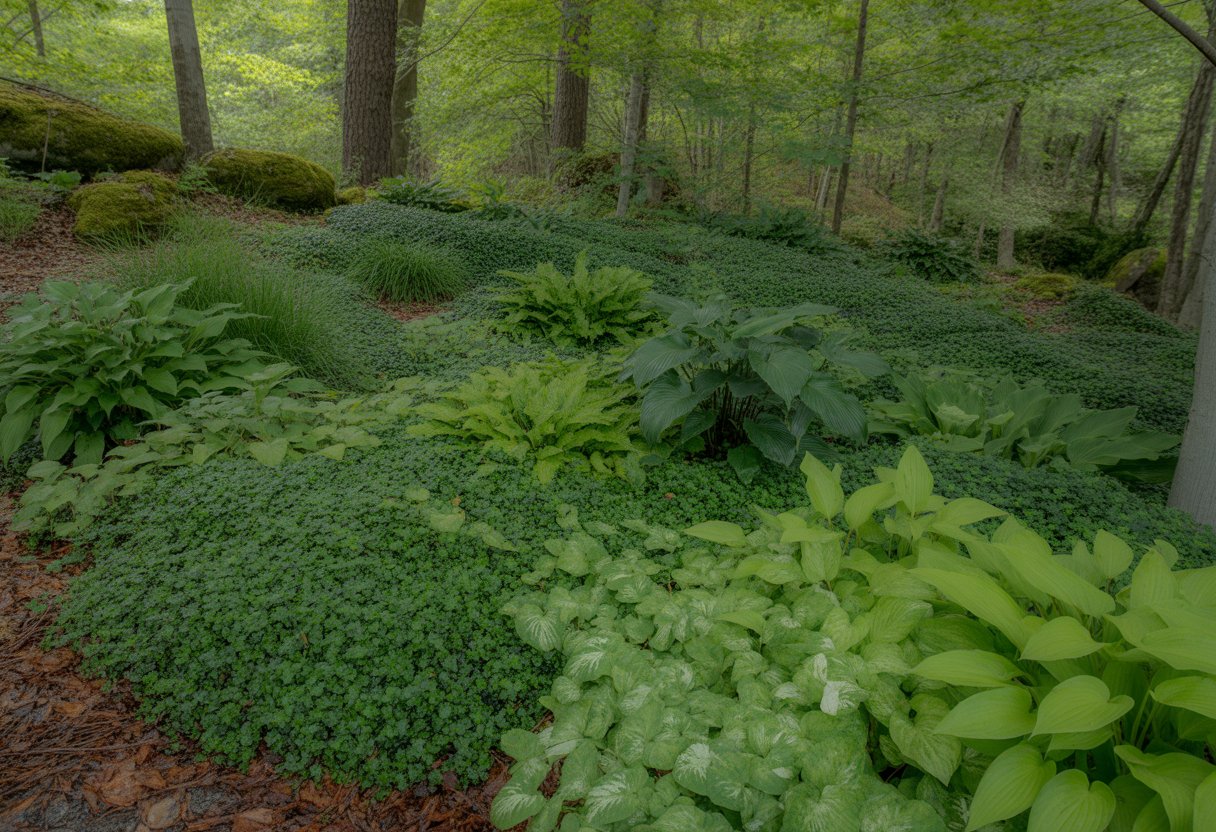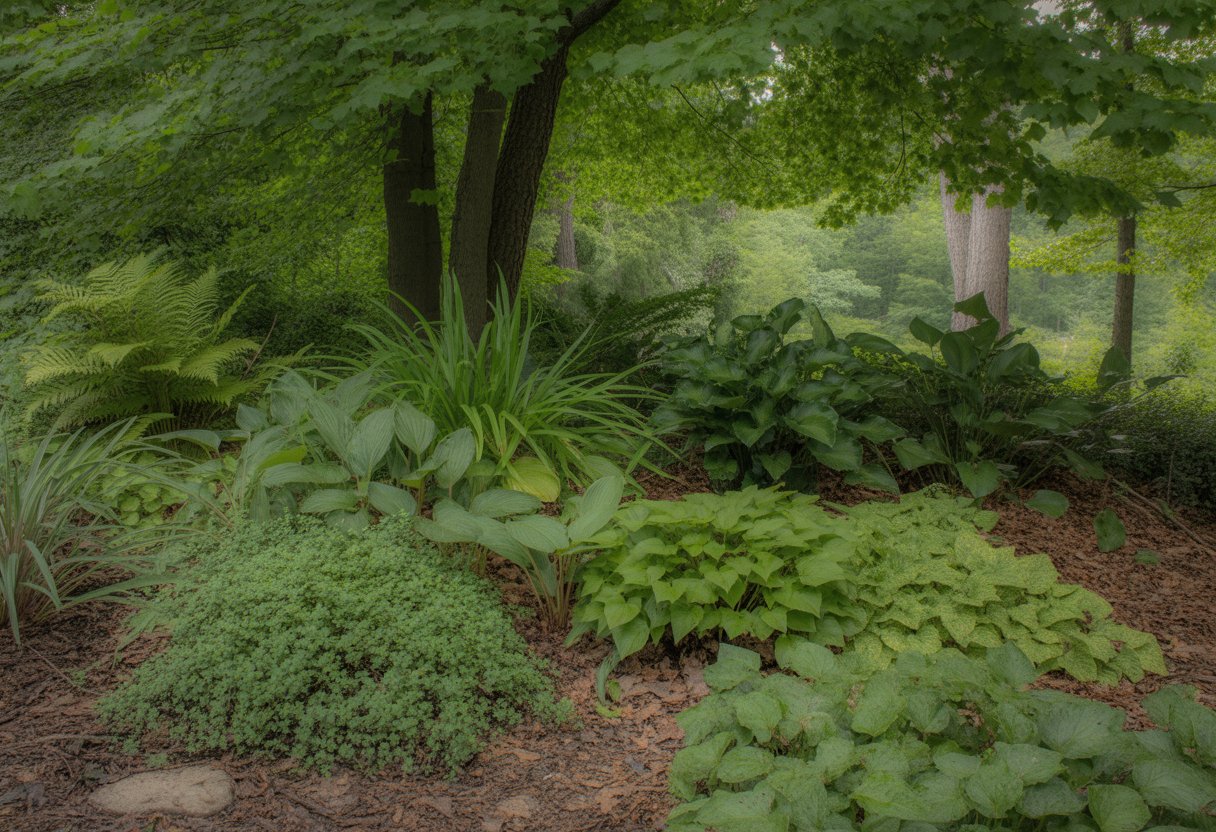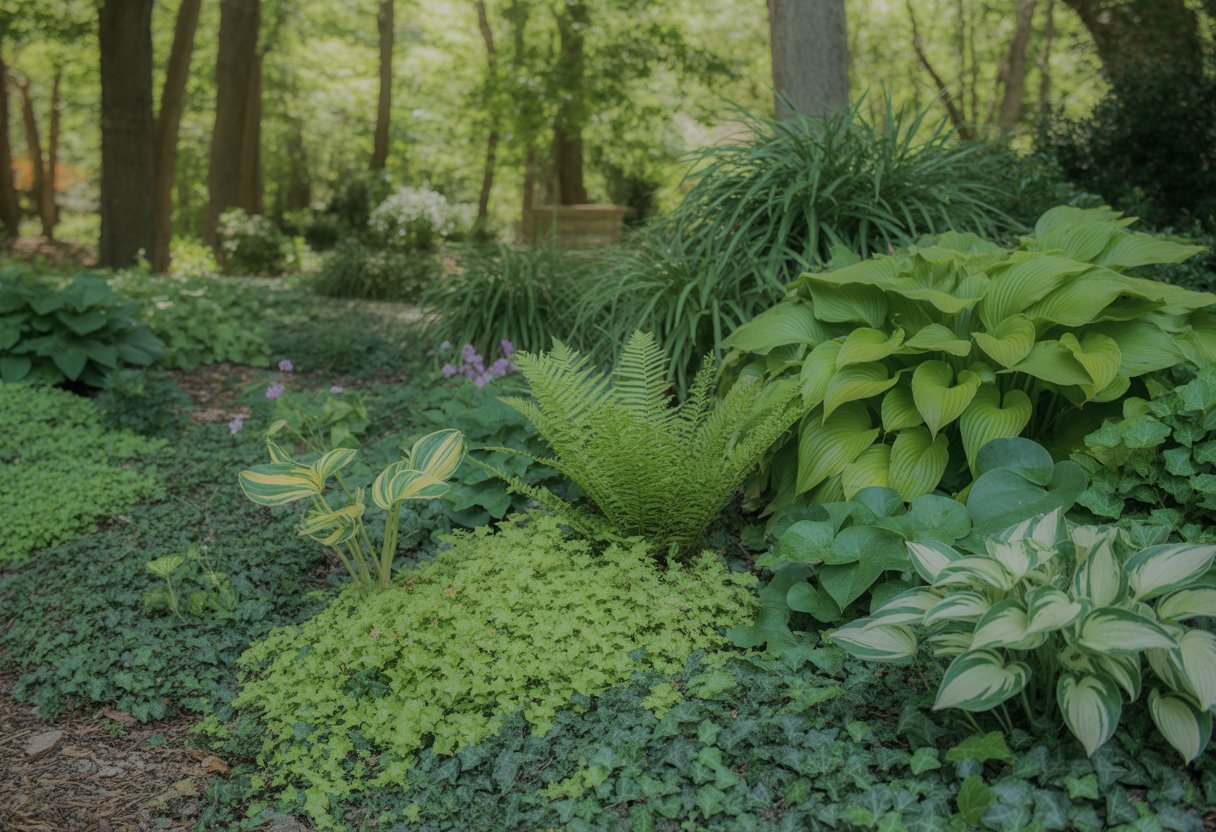Shade Loving Ground Covers New Hampshire: Best Varieties for Low-Light Gardens
Many gardens in New Hampshire have shaded patches where regular plants just don’t do well. Picking the right ground covers for those tricky spots can boost soil health, cut down on erosion, and make the yard a little more interesting—without demanding a ton of work.
Shade-loving ground covers like pachysandra, ferns, and hostas really shine in New Hampshire’s climate and low-light corners.

These plants handle the cool, moist air here and grow just fine beneath trees or along the north side of a house. If you pick species that fit the local shade, you’ll get lasting coverage and barely have to fuss over them.
Anyone looking for reliable ground covers should spend a little time learning which ones actually thrive in New Hampshire.
Understanding Shade Loving Ground Covers in New Hampshire

Shade-loving ground covers play a big part in New Hampshire landscapes, especially where sunlight doesn’t reach much. They’re well adapted to the region’s weather and unique shade, giving gardeners options for those tough, dim spots.
New Hampshire Climate and Shade Conditions
New Hampshire’s climate swings between cold winters and humid, warm summers. Shade-loving plants here need to handle those temperature ups and downs and sometimes unpredictable moisture.
Shade usually comes from dense trees or big buildings. Sometimes it’s full shade, with barely any direct sun, or partial shade, where a bit of light sneaks through.
A lot of garden beds deal with dry shade—think under old trees where roots hog the water. Ground covers that work here have to be both drought-resistant and able to handle the shade.
Defining Shade and Shade Garden Zones
Shade in garden design boils down to how much sun the area gets each day.
- Full shade: Less than two hours of direct sun.
- Partial shade: About two to four hours, usually filtered.
- Dry shade: Shady spots with low soil moisture.
These zones matter a lot. If you figure out the right shade zone, you’ll pick plants that actually survive, and you won’t be stuck replanting every year.
Here, ground covers need to match their little microclimate. Moisture, soil, and how much shade all play a role.
Benefits of Ground Covers for Full and Dry Shade
Ground covers in full and dry shade keep soil in place and help block weeds by forming a thick mat. They need less water and care compared to grass, which usually struggles in these areas.
They also add texture and steady greenery through the growing season. In dry shade, the right ground covers protect soil and even help tree roots by keeping the ground undisturbed.
Top Shade Loving Ground Covers for New Hampshire Gardens

Picking ground covers for shade in New Hampshire is a bit of a balancing act. You want evergreen presence, maybe some seasonal blooms, and definitely drought tolerance.
These plants do best under trees and shrubs, giving your garden texture, color, and something to look at all year.
Evergreen Perennials and Year-Round Appeal
Evergreen ground covers like Pachysandra terminalis and Vinca minor keep their leaves through winter. They make a dense, green carpet under trees, holding soil in place.
Semi-evergreen types, like Liriope spicata, might lose some leaves to frost but bounce back quickly in spring. They take New Hampshire’s cold and summer heat in stride.
Both kinds do best in well-drained soil with a bit of moisture. Just keep an eye out for debris, since shaded and damp spots can get fungal problems if you let leaves pile up.
Showy Flowers and Foliage for Borders
Flowering ground covers like Tiarella cordifolia and Heuchera add pops of color along paths and borders. Their leaves come in all sorts of patterns, so they look good even when not blooming.
Epimedium brings delicate flowers and heart-shaped leaves, and it handles dry shade better than most. It’s a solid choice for planting under big old trees.
Give these plants rich, well-composted soil. If you deadhead spent flowers, you’ll get more blooms through summer.
Drought-Tolerant and Low-Maintenance Options
If your shady spots get dry or you just don’t want to water much, try Sweet Woodruff (Galium odoratum) or Ajuga reptans. Both need almost no care once they’re settled in.
Ajuga spreads fast and makes a thick mat that keeps weeds out. Sweet Woodruff throws out fragrant white flowers in spring and handles the up-and-down moisture under trees.
Don’t overwater—these guys hate soggy roots. Choose them if you want to spend less time fussing and more time enjoying the garden.
Noteworthy Shade Plants and Featured Varieties

A few shade-loving ground covers really stand out in New Hampshire. They offer unique foliage, interesting growth habits, and sometimes even cool flowers.
These plants bring color and texture to dark corners, plus they help with erosion and weed control.
Hosta and Variegated Foliage Types
Hostas are a classic pick, and for good reason. Their leaves come in deep green, bright chartreuse, and all sorts of variegated patterns.
Some have smooth leaves, others are rippled. They’re tough perennials that handle New Hampshire’s weather just fine.
You’ll want to give them well-drained soil and enough water. Hostas do great in deep shade, whether under trees or along borders.
Ajuga and Compact Growth Habits
Ajuga, or bugleweed, is a favorite for its dense, low-growing habit. In spring, it sends up spikes of blue or purple flowers that really pop against the dark leaves.
Ajuga works well for erosion control, especially on slopes. It loves moist, well-drained soil and spreads out fast, so weeds don’t stand a chance.
Compact types fit nicely in tight spaces or between stepping stones.
Epimedium wushanense ‘Sandy Claws’ and Related Barrenworts
Epimedium wushanense ‘Sandy Claws’ is a bit of a show-off with its unusual leaves and late spring lavender flowers.
This barrenwort does well in dry shade and, once it’s settled, doesn’t mind a little drought. New leaves come in creamy, then shift to a soft green.
Other barrenworts have similar perks—delicate flowers, textured leaves, and a knack for thriving in woodland gardens.
Design Tips and Care for Shade Loving Ground Covers
If you want your ground covers to actually thrive, pay attention to soil moisture, sunlight, and which plants play nice together. Stick with species that can handle dry shade in New Hampshire, and you’ll have fewer headaches.
Mixing in plants that support pollinators and combining different textures makes your garden more interesting and useful.
Planting in Dry Shady Areas
Dry shady areas are tricky—low water, not much sun. Ground covers like Epimedium and Pachysandra can take it.
They prefer well-drained soil, but during really long dry spells, they’ll appreciate a drink. Adding compost or leaf mold helps the soil hold onto moisture.
Avoid heavy clay if you can—it just holds too much water. Give your plants enough space for air to move, which helps keep fungal problems away.
Mulch with leaf mold or wood chips to save water and keep weeds at bay. Plus, it breaks down and feeds those shallow roots.
Attracting Pollinators and Enhancing Biodiversity
Even in shade, you can attract pollinators by picking plants with flowers. Try Trillium or Japanese Anemone—they offer nectar and pollen, and they’re pretty adaptable.
Mixing in a variety of flowering ground covers supports bees, butterflies, and other helpful bugs. That boosts your garden’s health and resilience.
Skip the heavy-duty pesticides if you want to keep those pollinators around. Tossing in a few logs or stones gives insects places to hide, which helps keep the ecosystem balanced.
Combining Grasses, Shrubs, and Groundcovers
Mixing grasses, shrubs, and ground covers really brings layers and visual interest to shaded gardens. Shade-tolerant ornamental grasses like Hakonechloa from Asia add some texture and a gentle sense of movement, even though they don’t need full sun.
Shrubs such as Rhododendron or Azalea give you height and bursts of color right under tree canopies. Ground covers, planted in the right spots, fill empty spaces and help keep weeds down.
Choosing plants with different heights and shapes means you catch more light and use space better. Plus, it’s a smart way to prevent erosion on slopes and encourage healthier soil, thanks to all those roots spreading out.


